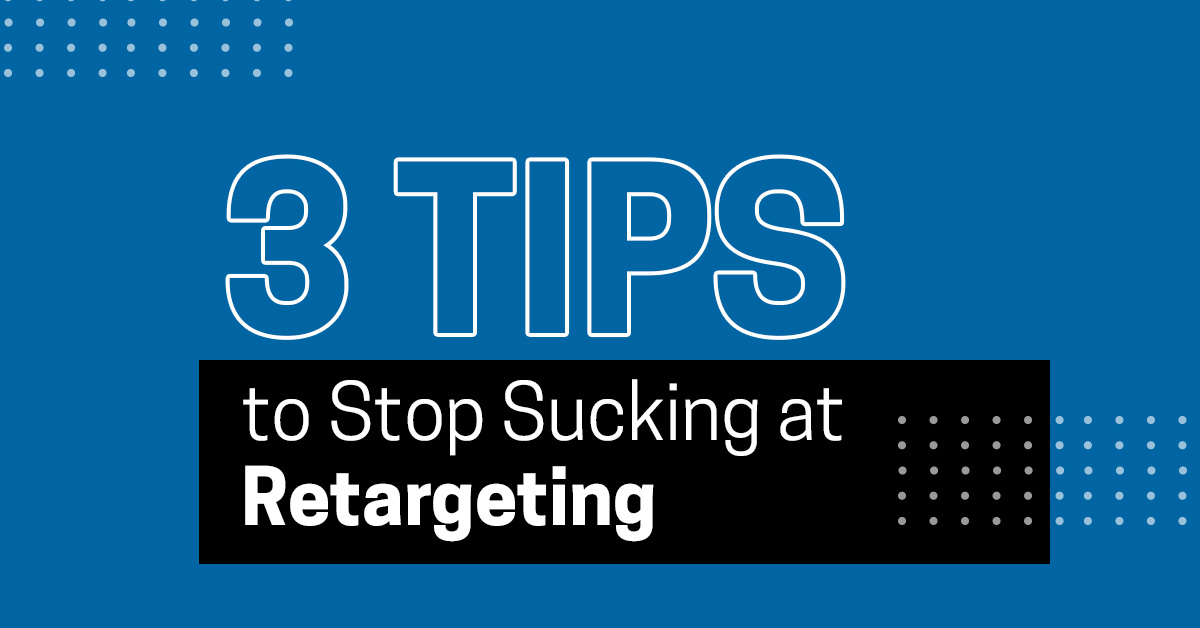If you had the choice between marketing to a completely “cold” audience that had never heard of your product or service, and marketing to an audience that was already familiar with you and your brand, which would you choose? Like most of us, you’d go with the familiar audience, and it’s not a hard choice – statistics show that audiences are overwhelmingly more likely to click on retargeting ads than they are regular display ads, and they’re more likely to convert, as well.

It’s no wonder, therefore, that retargeting has become such a key part of the digital marketing industry. The bang for your buck is simply much, much higher.
However, the “more bang for your buck” factor is contingent on one thing: doing retargeting ads correctly. And, to be brutally honest – many of us in the marketing industry aren’t doing retargeting ads right. We’re leaving good money on the table, if not pushing it into a fire.
So, in this blog, let’s talk about what marketers are doing wrong with retargeting, and how we can fix these issues.
Now, if you’ll forgive me putting on my ranting hat:
Marketers, Why Do So Many of Us Suck at Retargeting?
A Year of Wasted Retargeting Ads
In 2021, I saw ads for an herbal dietary supplement that claimed to have several health benefits. I was in the middle of a health kick at the time, and thought this might be an excellent booster for my efforts. Needless to say, the booster didn’t work as well as advertised (ah, foolish me – marketing really does work sometimes!) and I declined to purchase any more when my supply ran out.
I purchased the supplement on June 14, 2021. To this day, over a year after I last went to the manufacturer’s web site, I’m still seeing pre-roll YouTube ads for their various products. It’s been a year! (And let’s say nothing of how apparently useless the YouTube option to “stop seeing ads like this” is; that’s a rant for another day).
When I see these ads, they annoy me as a consumer – who likes seeing an ad for a product they have no interest in buying? But they infuriate me as a marketer. Every pre-roll YouTube ad I roll my eyes and tab out from watching (or wait until the Skip Ads option shows up) is advertising budget wasted on someone who clearly has no intent of purchasing. And, again, this has been going on for over a year, and multiple times a day at that.
This is bad retargeting!
Your Ad Already Worked – Stop That
This spring, I moved into a new apartment elsewhere in my home city of Portland, and have been rather satisfied with my new residence. It came as a surprise, therefore, when a recent YouTube pre-roll ad was not for the dietary supplement company mentioned in the first example, but instead for the apartment complex I’d moved into not a month before. I could attest first-hand to many of the amenities advertised – fitness center complete with climbing wall, rentable media room, gorgeous rooftop space for gatherings and other events – because I’d already been experiencing them. Since I lived there!
It wasn’t much of a surprise why that one started showing up, once I gave it some thought. I’d Googled the apartment complex’s home page to log in to their residential portal as a way to set up my bill payment. From a very surface-level perspective, I was just the same as any other prospective renter looking for a place to live in a trendy part of town. Why wouldn’t they retarget ads at me?
How Many Beds Do You Think I Need?
As part of the aforementioned move last spring, I decided that it was time to finally upgrade from my smaller, older mattress and get a nice, luxurious bed that would last me the next decade and beyond. My partner and I did considerable research both on and offline before we settled on a purchase that we were both satisfied with.
And ever since then, I’ve gotten ads for mattresses and beds. I’ve already got a mattress and a bed! What, do you think I’m some sort of bed collector?
(This has some overlap with the example above, but I think there’s enough of a distinction to make it its own gripe entirely. After all, with one, I purchased from that specific individual, but with the other, I made a purchase in general – not necessarily from the brands showing me ads.)
This experience reminded me of the time I bought a PlayStation 4 online in the mid-2010s, only to be inundated by PS4 ads on every site I went. I’ve already got the PS4, thanks!
3 Tips to Stop Sucking at Retargeting Ads

For every one of these gripes above, I’ve got good news: there’s a fix! These are easy problems to fix – well, two out of three are easy problems to fix, at any rate – so let’s look at how these issues could be corrected.
Retargeting Ad Fix #1: Know When to Fold ‘Em
We all dream of catching that customer who got away – they bought from you once, after all, so why wouldn’t they do so again? Well, maybe they weren’t satisfied with your product. Maybe they’ve found an alternative. Maybe they just don’t have a need for your product or service in their lives anymore.
Whatever the case, you need to accept that at some point, this person just isn’t going to convert again, and wasting money on ads over a year from their most recent purchase is throwing good money away. When you set a retargeting campaign, you can select a length of time for it to continue (usually 30, 60, or 90 days) – and you absolutely should set an end date rather than letting it run in perpetuity.
If I’m still getting ads one year after purchasing your product, you’re doing something wrong!
Retargeting Ad Fix #2: Set Your Campaigns Up to Take a Win
On the other end of the spectrum, there’s this – when your retargeting ad succeeds, knock it off! There’s nothing more irritating for a customer than seeing repeated ads they don’t want, and this doesn’t just include products they don’t like, it includes things they did like, and liked enough to buy them!
Whatever campaign you set up should have an “off” switch. Typically, for an ecommerce brand, this might be set up on the purchase confirmation page of your site – include a targeting pixel on this page that removes the customer from any ad campaigns currently aimed at them.
You can remarket to them later with future products, refills, and the like, but for the time being, you should end the successful campaign rather than just annoy them with the same repeated ads that got them to convert in the first place.
Retargeting Ad Fix #3: Embrace “Parallel Retargeting” to Change Your Offer
Okay, I’ll fess up – this one’s a little bit of a stretch compared to the others. After all, “displaying ads based on search terms” isn’t necessarily retargeting, it’s normal PPC! But targeting shoppers doing their research has a lot of overlap with retargeting campaigns – people who have visited your page, or even left a shopping cart abandoned on your site, for instance.
This is the trickiest problem of all to solve from a retargeting standpoint. After all, it’s hard to tell when someone has bought a product from someone who isn’t you!
Setting an expiration date, as in tip #1 above, will help with this – after all, someone who’s searched for information on a purchase, whether a bed or a PS4, has probably made that purchase within 90 days.
Here’s another suggestion, though: Why not reconsider what you’re offering?
There are two primary types of retargeting campaigns people can use. The most common is personalized or behavioral retargeting – displaying ads based on peoples’ behavior. If they’ve visited a product page on your site, you show them ads for that product. Another type is contextual retargeting – this is less about what an individual has done and more about predicting what people will do. For instance, running ads for a car parts shop on a blog dedicated to car repair tips.
I’m going to try to come up with a third type. Let’s call it parallel retargeting – this is using standard retargeting tips, but for different (and complementary) products that the person may not have already bought as part of their current product search.
For instance, instead of beds or mattresses, you could push mattress toppers or, better yet, bed sheets – things that most people do need multiples of! Pillows, straps to keep bedsheets from riding up, mattress protectors, and more are all examples of things you could target to someone who may already have bought their bed and isn’t going to want another one. Similarly, if someone searched for a PlayStation 5, why not advertise PS5 games or accessories? (Just kidding, we all know they haven’t been able to find a PS5 in stock yet.)
Retargeting Ads Can Be Hugely Beneficial (When Done Right)
As we mentioned at the start of the piece, retargeting ads can really be great at driving impressions, clicks, and conversions. But it’s important to do them well to see the full benefit for your business. Otherwise, you’ll find yourself wasting good money on customers who won’t ever convert – or worse, customers who already converted but who are now being irritated into stopping engagement with your brand!
To recap, the three tips of doing retargeting right:
- Set proper end dates on your retargeting campaigns (we recommend 90 days at max);
- Have an end condition for campaigns that wound up being successful;
- Consider “parallel retargeting,” where you sell complementary products or services, rather than trying to chase shoppers who’ve already bought a product and don’t need it anymore.
If you want expert retargeting advice for your next campaign, contact SevenAtoms today. We’ll get you started on smart, effective retargeting ad campaigns! (And we won’t be fruitlessly running them a year after a customer’s last purchase. We promise.)










